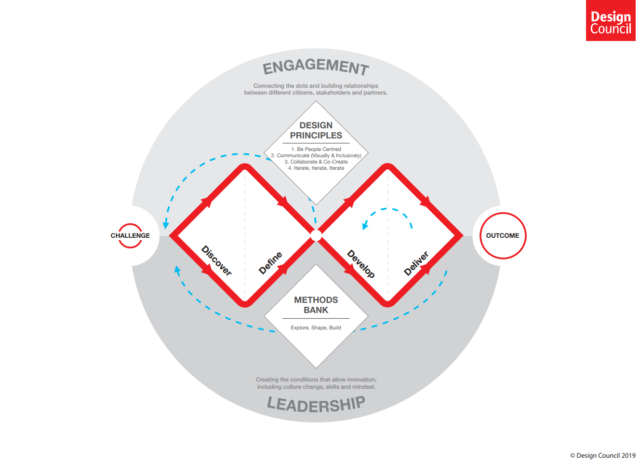
- Software Development
Design Thinking is not a new subject at SoftDesign. We apply this approach every day to develop digital products. That is why we understand the complexity of this framework and so, today, the topic here is about one of the most interesting tools of DT: the Double Diamond.
Launched in 2004 by the English institution Design Council, Double Diamond is a diagram formed by two diamonds and four triangles, which aims to favor creative processes through design. Initially, it was used only by designers, but over time, its applicability in the most diverse areas of business proved to be useful, mainly to favor innovation. Let’s understand this better?
In the proposed diagram, the diamonds represent divergent and convergent thoughts. They are interspersed in the four triangles that symbolize the discover, define, develop and deliver phases: the first two are related to exploring the problem, while the last two are related to solving that problem.
The model starts with a challenge, which could be a problem to be solved within an organization or the need to create a new product. A multidisciplinary team composed of different people, partners, and stakeholders engages in solving the challenge based on four principles: 1) Focus on people; 2) Visual and inclusive communication, 3) Collaboration and co-creation; and 4) Constant iterations. Going through the phases of discovering, defining, developing, and continuously delivering, the goal is to design an innovative solution.

The first phase focuses on exploration. The brainstorming technique is recommended, as it is the best time to discuss ideas, share opinions and diverge. It is important to be open to receiving information and thinking about it, listening empathically, putting yourself in people’s shoes.
Research techniques are also welcome, as they help not only to understand the problem but also to identify users’ needs. But remember: it is important to work with valid data samples. Conducting just one interview or asking if the person would use the product, for example, is not enough.
The second phase of Double Diamond works with the information gathered in the previous phase. Now the effort is towards the convergence of ideas and the effective definition of the problem. This is why this phase is also understood as a delimiter: all the people on the team need to determine a common and single objective.
Personas must also be established at this phase, as well as their behaviors, thoughts, and experiences. The Empathy Map is a technique that can help with this, in addition to User Journey studies.
In the second diamond, the third phase starts, again, with brainstorming techniques. At this point, the divergence of ideas focuses on possible ways to solve the problem. This means that technical solutions need to be raised, considering their execution possibilities.
The focus remains on the users, so all solutions must be designed to satisfy their needs and expectations. A critical point here is to remember that this is a phase of divergence, that is: the objective is not to create a solution but to think and explore multiple ideas for solutions, and then, in the next phase of convergence, to funnel again, choosing the one the team wants to proceed with.
Finally, it is time to deliver the result of this Double Diamond cycle. This means that you need to understand the potential of the solution(s). The level of complexity and fidelity of testing conducted with them depends on where you are in your product lifecycle.
In an initial framework cycle, it is normal for testing to consist of evaluating low-fidelity prototypes. In a later cycle, delivery can be the test of an MVP. The important thing is that this phase brings more data so that the team can decide between one of the following three options:
In the diagram image, if you look at the blue dotted line, you will notice that it runs along different paths. This means that the four phases of Double Diamond do not always have to be performed in sequence.
If after Discover and Define, the team thinks it needs to go back to the first phase, there is no problem in doing so. It is best to start the second diamond with a clear definition of the problem and personas, to avoid rework. Likewise, if after delivery, the solution is not well received by users, it is worth re-developing before abandoning the project.
This framework is one of our favorites. It helps us explain to the teams we work with that divergence is very important to innovation and that convergence is necessary to proceed.
Our Product Conception is the first iteration of Double Diamond! In it, we usually collect the first research data, manage to create the first definition of the central problem of the product, and then work on solutions with low-fidelity prototypes.
After this step, during the Experimentation or Development of digital products, we continue to diverge and converge, increasingly with more real market data, and with more adequate and complete solutions.
Thinking about applying the Double Diamond approach to get your idea off the ground? Contact us so we can help!
